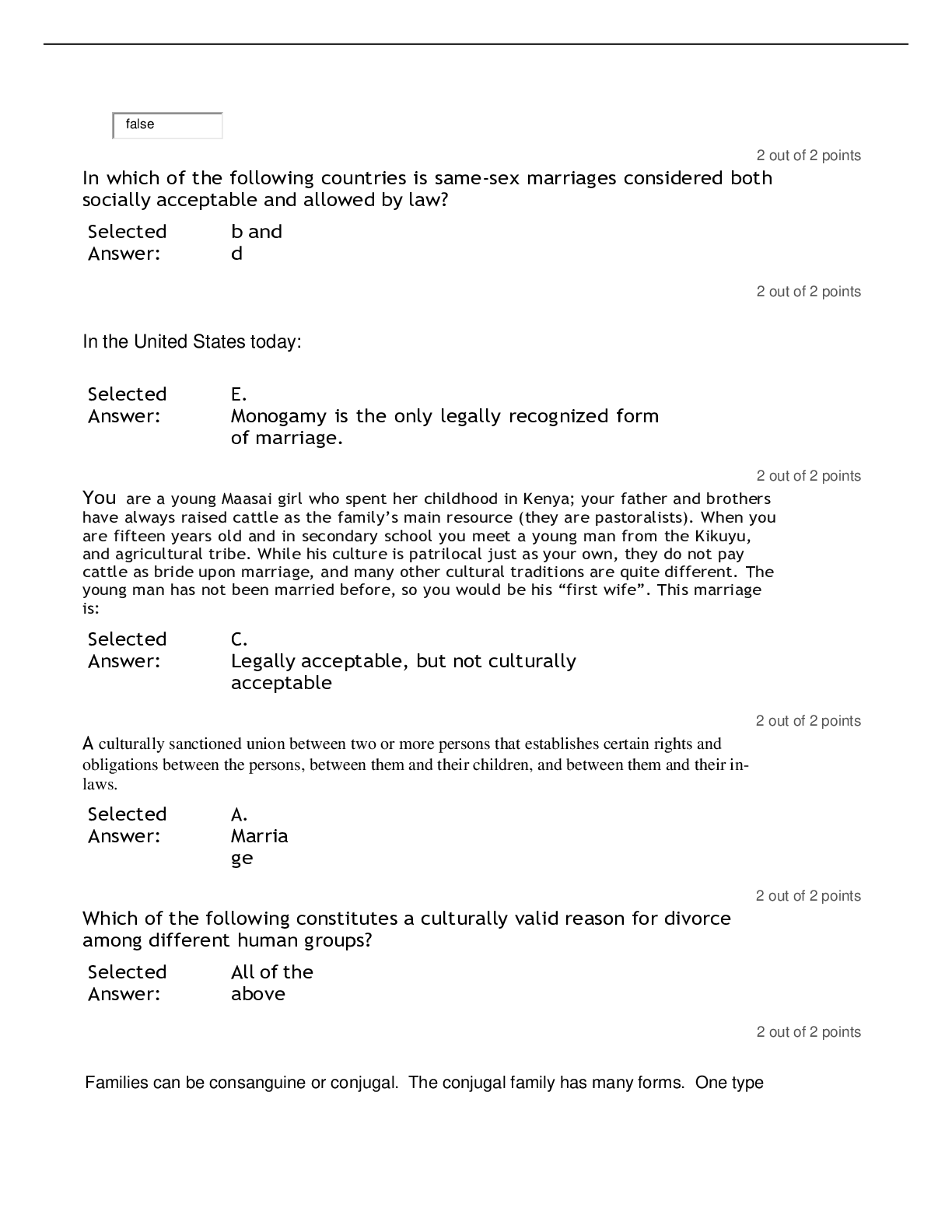Anatomy and Physiology - A&P 2 > EXAM > Straighterline AP2 202 Anatomy & Physiology 2 A&P 2 test 6 Grade 38.00 out of 40.00 (95%) (All)
Straighterline AP2 202 Anatomy & Physiology 2 A&P 2 test 6 Grade 38.00 out of 40.00 (95%)
Document Content and Description Below
Straighterline AP2 202 Anatomy & Physiology 2 A&P 2 test 6 Grade 38.00 out of 40.00 (95%) Question 1 Question text What is the function of the nasal conchae? Select one: a. increases turbulenc... e in the airflow b. olfaction c. increases surface area for cleaning, warming, and moisturizing the air d. increases turbulence and surface area for cleaning, warming and moisturizing the air Question 2 Question text A person has severe damage or disease in the upper area of their right lung. Surgery is necessary. The doctor would need to remove Select one: a. the entire right lung. b. the superior lobe of the right lung. c. the apical bronchopulmonary segment of the right lung. d. only the damaged area of the apical bronchopulmonary segment. e. the apical, anterior, and posterior segments of the superior lobe.. Question 3 Question text The largest division of each lung are _____, which are divided into _____. Select one: a. lobules; segments b. segments; lobules c. lobes; lobules d. segments; lobes e. lobes; segments Question 4 Question text Which of the paired cartilages of the larynx articulate with the cricoid cartilage? Select one: a. Thyroid b. Corniculate c. Cuneiform d. Epiglottis e. Arytenoid Question 5 Question text Which of the following is a passageway for both air and food? Select one: a. trachea b. larynx c. pharynx d. bronchus e. esophagus Question 6 Qustion text Whose law explains that an increase in volume causes a decrease in pressure? Select one: a. Henry's Law b. Dalton's Law c. Charles Law d. Boyles Law Question 7 Question text When the inspiratory muscles contract, Select one: a. thoracic volume increases. b. pleural pressure increases. c. the alveolar pressure increases. d. expiration occurs. e. thoracic volume decreases. Question 8 Question text The volume of air available for gas exchange per minute is called the Select one: a. vital capacity. b. alveolar ventilation. c. minute respiratory volume. d. functional residual capacity. e. respiratory rate. Question 9 Question text Mr. Huff and Puff exhales normally; then, using forced expiration, he exhales as much air as possible. The volume of air still remaining in his lungs is called Select one: a. expiratory reserve volume. b. tidal volume. c. inspiratory reserve volume. d. vital capacity. e. residual volume. Question 10 Question text Physiological dead air space is anatomic dead space plus Select one: a. the residual volume. b. the volume of any alveoli where gas exchange is diminished. c. the volume of blood flowing to the lungs. d. the respiration rate. e. tidal volume. Question 11 Question text Internal respiration refers to Select one: a. atmospheric air coming into the lungs. b. gas exchange between the lungs and the blood. c. gas exchange in the atmosphere. d. gas exchange between the blood and body tissues. e. cellular respiration. Question 12 Question text When 2,3-bisphosphoglycerate (BPG) levels increase, hemoglobin Select one: a. releases less oxygen to tissues. b. releases more carbon dioxide to tissues. c. releases more oxygen to tissues. d. releases less carbon dioxide to tissues. e. None of these choices is . Question 13 Question text Gas exchange between the air in the lungs and the blood takes place in the Select one: a. alveoli. b. primary bronchi. c. terminal bronchioles. d. trachea. e. respiratory bronchi. Question 14 Question text Why is transfused blood discarded after about 6 weeks of storage? Select one: a. It can not bind to oxygen anymore. b. It becomes too thick. c. The BPG levels are too low for adequate release of oxygen to tissues. d. The percent oxygen saturation is too low. Question 15 Question text In which of the following sequences does PO2 progressively decrease? Select one: a. body tissue, arterial blood, alveolar air b. body tissue, alveolar air, arterial blood c. blood in aorta, atmospheric air, body tissues d. atmospheric air, blood in aorta, body tissues e. body tissue, aorta, alveolar air Question 16 Question text During exercise, ventilation initially increases due to Select one: a. increased blood carbon dioxide levels stimulating baroreceptors. b. decreased blood oxygen levels stimulating chemoreceptors. c. decreased blood pH levels stimulating baroreceptors. d. limb movements that stimulate the respiratory center. e. abrupt changes in metabolism or blood gases. Question 17 Question text Constriction of smooth muscle in the bronchioles Select one: a. occurs during periods of exercise. b. restricts the flow of air into the lungs. c. decreases ciliary action. d. increases airflow out of the lungs. e. does not affect airflow. Question 18 Question text Air in the pleural cavity is called Select one: a. emphysema. b. respiratory distress syndrome. c. a pneumothorax. d. pneumonia. e. forced expiration. Question 19 Question text Indicate the statement that describes respiratory function in a highly trained athlete at maximal exercise. Select one: a. Unchanged minute ventilation; increased respiratory rate; decreased vital capacity b. Increased residual volume, respiratory rate; decreased alveolar ventilation c. Increased tidal volume, unchanged minute ventilation and alveolar ventilation d. Increased minute ventilation and alveolar ventilation, unchanged tidal volume e. Increased tidal volume, minute ventilation and alveolar ventilation Question 20 Question text A respiratory disease characterized by decreased chloride ion diffusion out of cells and dehydrated respiratory secretions is Select one: a. bronchitis. b. emphysema c. cystic fibrosis. d. pulmonary fibrosis. e. lung cancer. Finish review Skip Quiz navigation Quiz navigation [Show More]
Last updated: 2 years ago
Preview 1 out of 9 pages

Buy this document to get the full access instantly
Instant Download Access after purchase
Buy NowInstant download
We Accept:

Reviews( 0 )
$7.00
Can't find what you want? Try our AI powered Search
Document information
Connected school, study & course
About the document
Uploaded On
Aug 04, 2022
Number of pages
9
Written in
Additional information
This document has been written for:
Uploaded
Aug 04, 2022
Downloads
0
Views
202

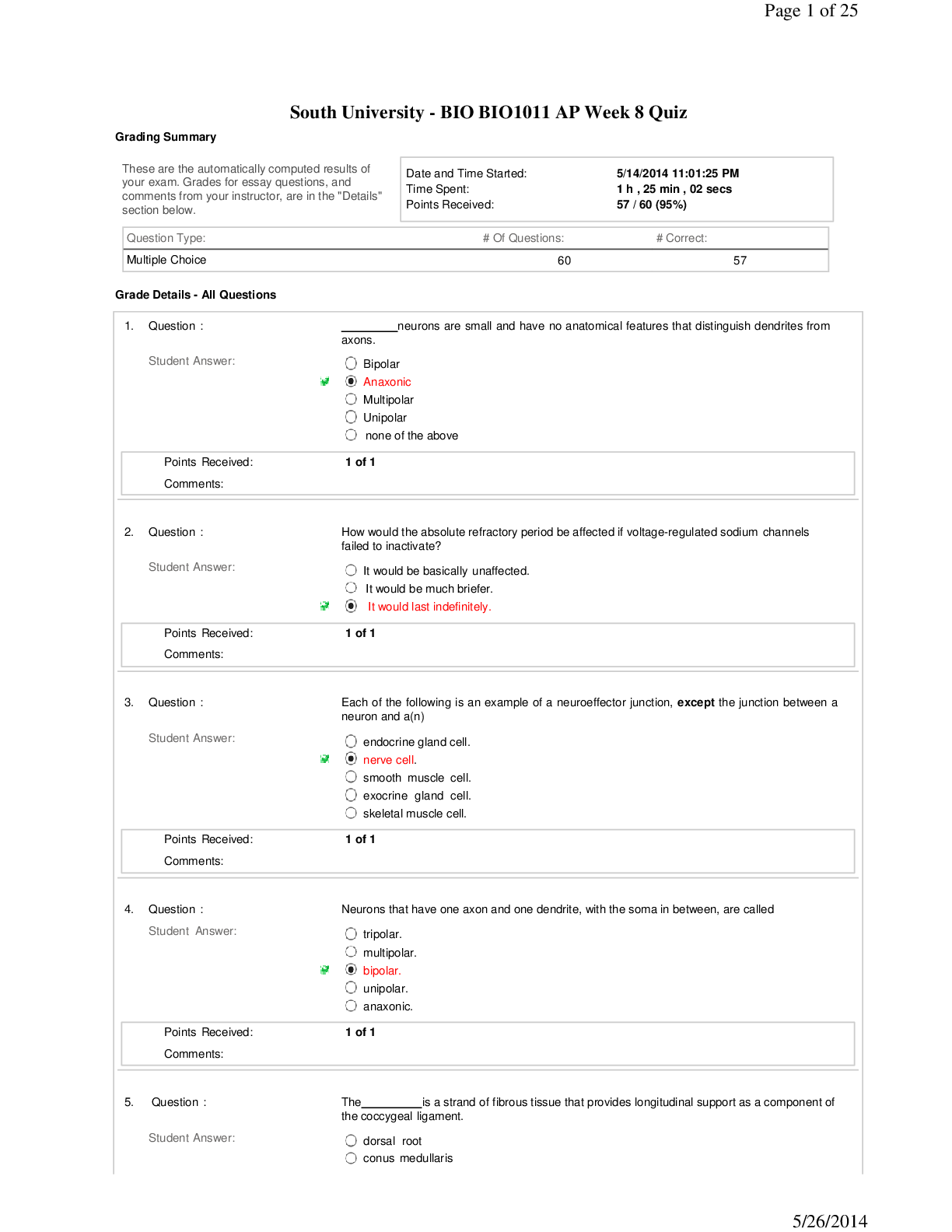
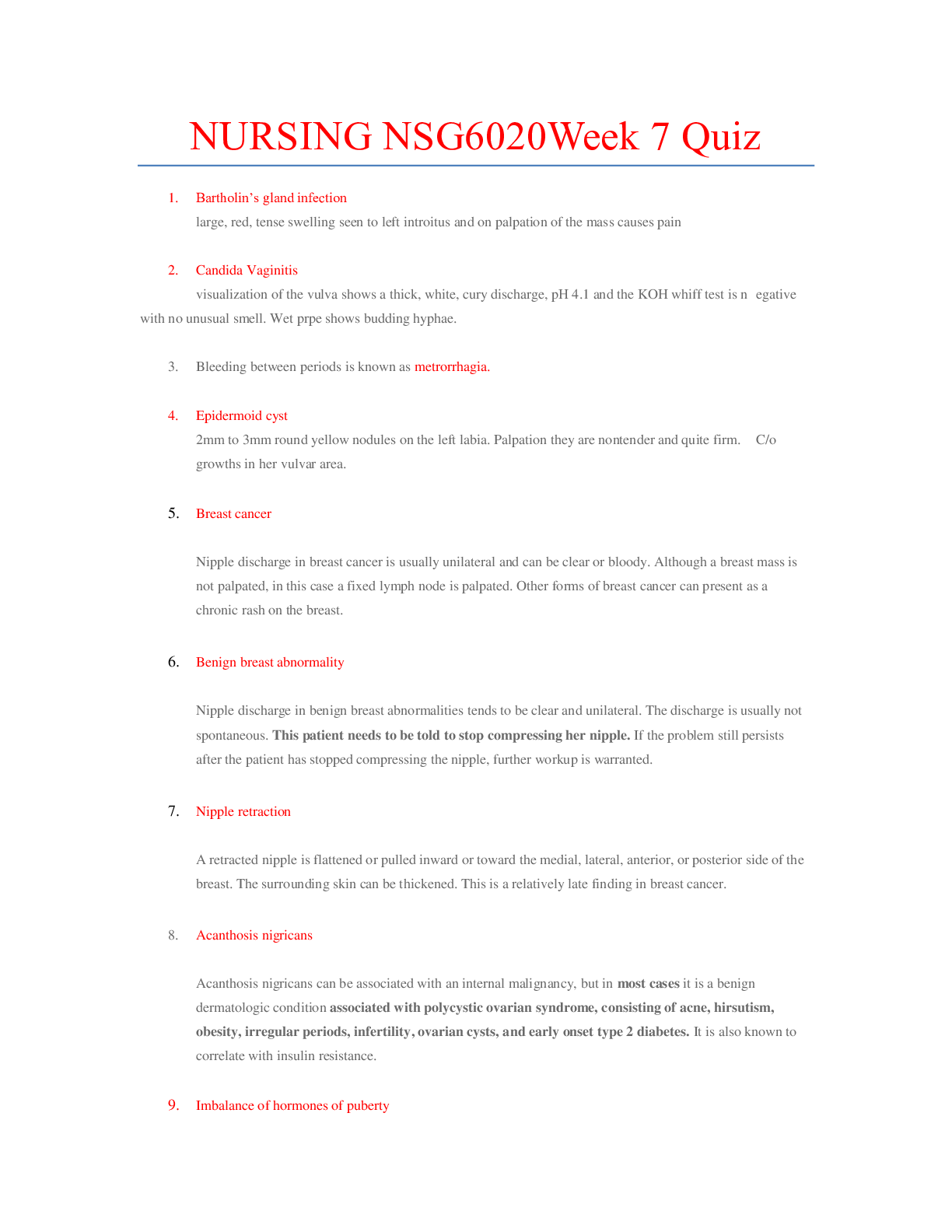
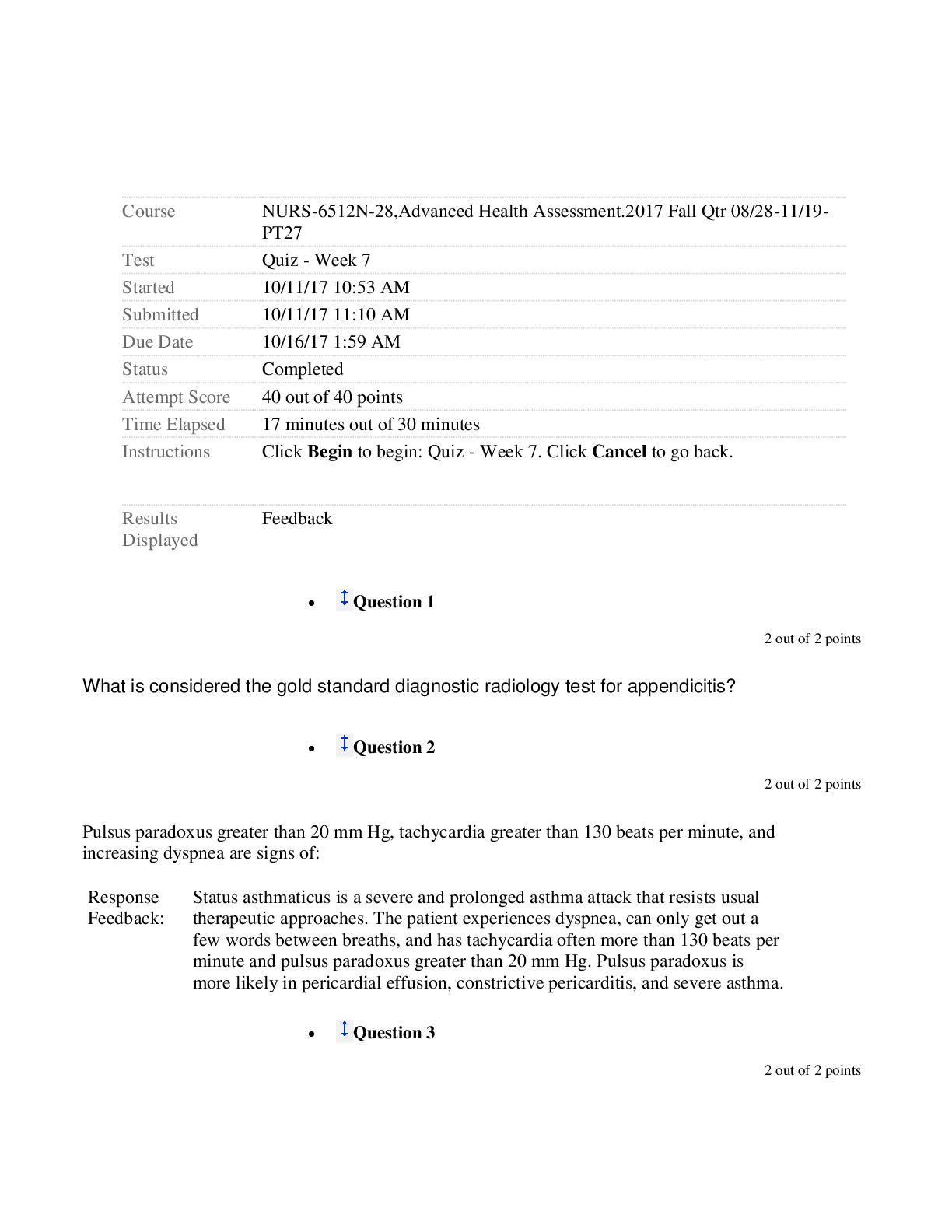



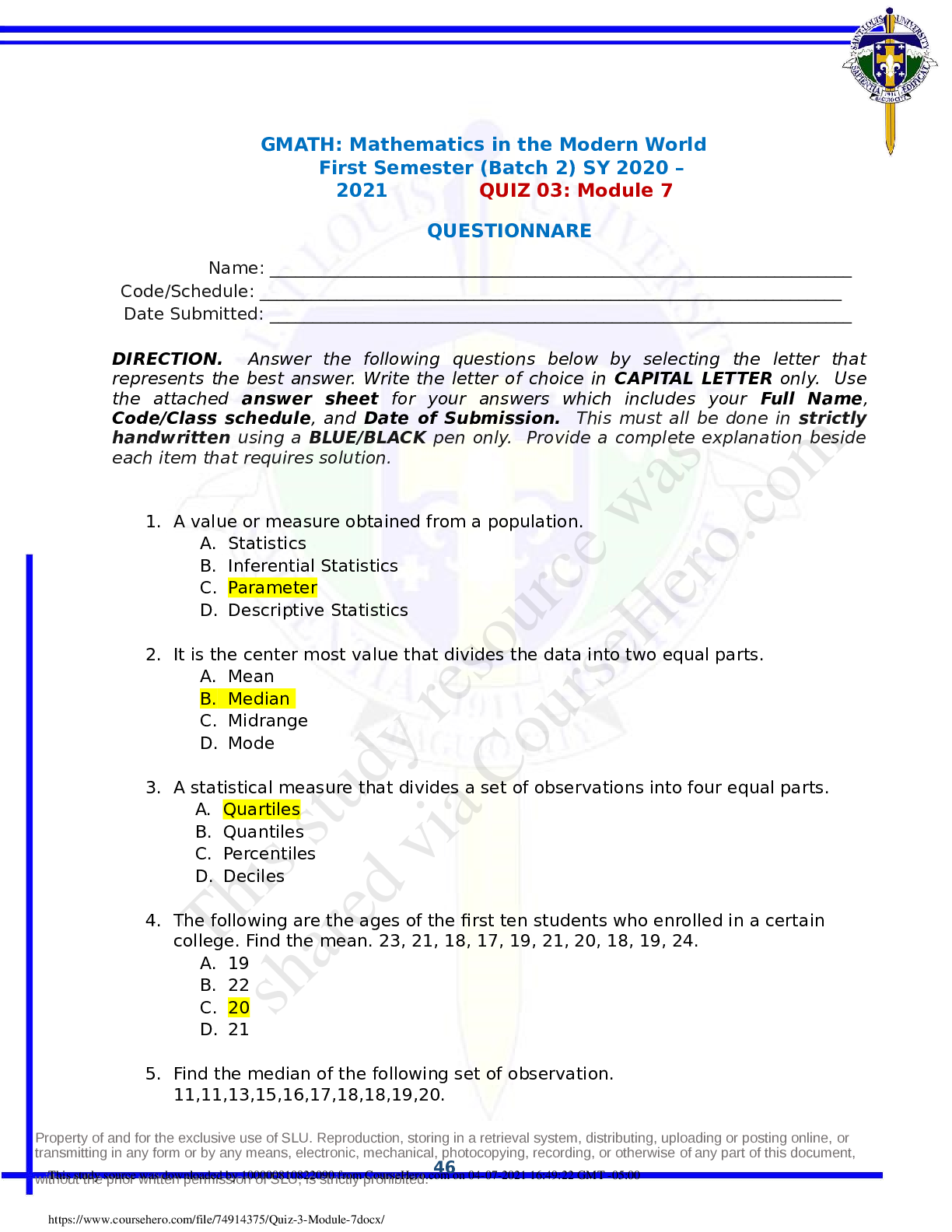



.png)

